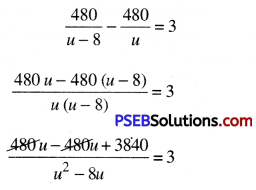Punjab State Board PSEB 6th Class Maths Book Solutions Chapter 7 Algebra Ex 7.3 Textbook Exercise Questions and Answers.
PSEB Solutions for Class 6 Maths Chapter 7 Algebra Ex 7.3
1. Pick the algebraic expressions and the arithmetic expressions from the following:
Question (i)
(i) 2l – 3
(ii) 5 × 3 + 8
(iii) 6 – 3x
(iv) 51
(v) 2 × (21 – 18) + 9
(vi) \(\frac {6a}{5}\) + 2
(vii) 7 × 20 + 5 + 3
(viii) 8.
Solution:
Algebraic Expressions :
2l – 3, 6 – 3x, 51, \(\frac {6a}{5}\) + 2
Arithmetic Expressions :
5 × 3 + 8, 2 × (21 – 18) + 9, 7 × 20 + 5 + 3, 8.

2. Write the terms for the following expressions:
Question (i)
2y + 5z
Solution:
Terms of 2y + 5z = 2y, 5z
Question (ii)
6x – 3y + 8
Solution:
Terms of 6x – 3y + 8 = 6x, -3y, 8
Question (iii)
7a
Solution:
Terms of 7a = 7a
Question (iv)
3l – 5m + 2n
Solution:
Terms of 31 – 5m + 2n = 31, -5m, 2n
Question (v)
\(\frac {2l}{3}\) + x.
Solution:
Terms of = \(\frac {2l}{3}\) + x = \(\frac {2l}{3}\), x
3. Tell how the following expressions are formed.
Question (i)
a + 11
Solution:
a + 11 = a is increased by 11

Question (ii)
12 – x
Solution:
12 – x = x is subtracted from 12
Question (iii)
3z + 8
Solution:
3z + 8 = Three time of z is increased by 8
Question (iv)
6 – 5l
Solution:
6 – 5l = 5 times of l is subtracted from 6
Question (v)
\(\frac {5a}{4}\)
Solution:
\(\frac {5a}{4}\) = 5 times a is divided by 4.
4. Give expressions for the following:
Question (i)
10 is added to p
Solution:
10 is added to p = p + 10

Question (ii)
5 is subtracted from y
Solution:
S is subtracted from y = y – 5
Question (iii)
d is divided by 3
Solution:
d is divided by 3 = \(\frac {d}{3}\)
Question (iv)
l is multiplied by – 6
Solution:
l is multiplied by – 6 = – 6l
Question (v)
m is subtracted from l
Solution:
m is subtracted from 1 = 1 – m
Question (vi)
11 is added to 3x
Solution:
11 is added to 6x = 6x + 11

Question (vii)
y is divided by -2 and then 2 is added to the result
Solution:
y is multiplied by – 2 and then 2 is added to the result = – 2y + 2
Question (viii)
c is divided by 5 and then 7 is multiplied to the result
Solution:
c is divided by 5 and thus 7 is multiplied to the result = \(\frac {7c}{5}\)
Question (ix)
x is multiplied by 3 then subtracted this result from y
Solution:
x is multiplied by 3 then subtracted this result from y = y – 3x
Question (x)
a is added to b then c is multiplied with this result.
Solution:
a is added to b then c is multiplied by this result = (a + b) c

5. Write the number which is 15 less than y.
Solution:
The number which is 15 less than y = y – 15
6. Write the number which is 3 more than a.
Solution:
The number which is 3 more than a = a + 3
7. Find the number which is 1 more than twice of x.
Solution:
The number which is 1 more than twice of x = 2x + 1
8. Find the number which is 7 less than 5 times of y.
Solution:
The number which is 7 less than 5 times of y = 5y – 7

9. Somi’s present age is ‘a’ years. Express the following in algebraic form:
Question (i)
Her age after 15 years.
Solution:
Somi’s present age = ‘a’ years
Her age after 15 years = (a + 15) years
Question (ii)
Her age 2 years ago.
Solution:
Her age 2 years ago = (a – 2) years
Question (iii)
If Somi’s father’s age is 5 more than twice of her present age, express her father’ age.
Solution:
Somi’s father’s age is 5 more than twice of her present age
∴ Her father’s age = (2a + 5) years.
Question (iv)
If Somi’s sister is 4 years younger to her. Express her sister’s age.
Solution:
Somi’s sister is 4 years younger to her
∴ Her sister’s age = (a – 4) years
Question (v)
If Somi’s mother is 3 less than 3 times her present age. Express her mother’s age.
Solution:
Somi’s mother is 3 less than 3 times her present age
∴ Her mother’s age = (3a – 3) years.

10. The length of a floor is 10 more than two times of breadth what is the length if breadth is l meters?
Solution:
The breadth of floor = l metres
The length of the floor is 10 more than two times of its breadth
∴ Length of floor = (2l + 10) metres.
![]()
![]()




